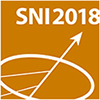Speaker
Description
Studies of the brain cytoarchitecture in mammals are routinely performed by histology, i.e. by examining the tissue under a light microscope after serial sectioning and subsequent staining. The procedure is labor-intensive and prone to artifacts due to the slicing procedure. While it provides excellent results on the twodimensional (2d) slices, the 3d anatomy can only be determined after aligning the individual sections, leading to a non-isotropic resolution within the tissue. X-ray tomography offers a promising alternative due to the potential resolution and high penetration depth which enables non-destructive imaging of the sample's density distribution at high detail. In order to visualize weakly absorbing soft tissue samples, the phase-shift induced in the (partially) coherent beam is used for contrast formation via free space propagation between the sample and the detector.
Experiments were carried out at our waveguide-based holo-tomography instrument GINIX at DESY. This setup allows for high resolution recordings with adjustable field of view and resolution. We optimize for contrast and resolution by comparing different preparation techniques, reaching sub-cellular resolution in mm-sized neuronal tissue from human and mouse. Subsequent automatic cell segmentation provides access to the 3d cellular distribution within the tissue, enabling the quantification of the cellular arrangement and allowing for extensive statistical analysis based on several thousands of cells.

